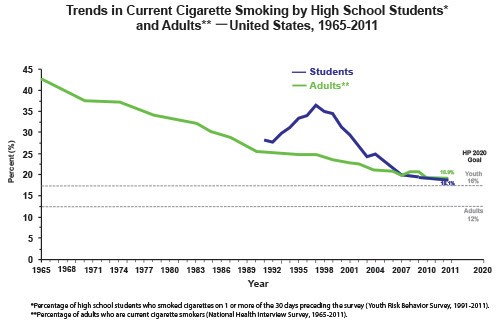Healthy Kids Can Coexist with Flavored E-cigarettes for Adults

 I’m “heartless” and “don’t care about the welfare of children.” At least, that is what I’ll be accused of when I say authorities should not ban the sale of fruit and candy-flavored electronic cigarettes despite the product’s potential appeal to minors. This is because fun flavors also appeal to adult smokers. More importantly, early research indicates that these flavors help smokers switch to vaping and not go back to their deadly traditional cigarette habit.
I’m “heartless” and “don’t care about the welfare of children.” At least, that is what I’ll be accused of when I say authorities should not ban the sale of fruit and candy-flavored electronic cigarettes despite the product’s potential appeal to minors. This is because fun flavors also appeal to adult smokers. More importantly, early research indicates that these flavors help smokers switch to vaping and not go back to their deadly traditional cigarette habit.
Five prominent health organizations, however, are asking the U.S. Food and Drug Administration to end the sale of flavored vapes, just as they did with traditional tobacco products. “As fewer kids smoke traditional cigarettes, tobacco companies are enticing them with a booming market of sweet-flavored tobacco products,” warned a March 2017 report signed by the American Academy of Pediatrics, the American Heart Association, the American Heart Association, the American Lung Association, and the Campaign for Tobacco Free Kids. According to these groups, such flavors “lure” children into nicotine use. As Matthew L. Myers, President of the Campaign for Tobacco-Free Kids put it “[t]obacco products simply shouldn’t be sold in flavors that appeal to kids.”
Is “wild berry” vape juice potentially attractive to kids? Possibly, but “fruit” flavored liquids are also wildly popular among adult vapers, many of whom have been able to quit smoking thanks to e-cigarettes. For example, a 2014 survey of e-cigarette consumers found that only 15 percent of vapers used “tobacco” as their primary flavor. It also seems that tobacco flavor is preferred in the early stages when a smoker first switches to vaping, with longer-term vapers preferring non-tobacco flavors. A 2013 study, published in the International Journal of Environmental Research and Public Health, found that of the more than 4,600 current e-cigarette users surveyed, over 91 percent categorized themselves as “former” smokers, and the majority of respondents indicated that flavor variety was very important to their efforts to quit. Most importantly, the study found that the number of flavors a vaper used was independently associated with smoking cessation.
It is possible that “tobacco flavor” is something smokers crave merely because of the association that forms between the taste and the effect of nicotine. Offering a variety of appealing non-tobacco flavors that still give users the nicotine “buzz” may help smokers dissociate tobacco taste from the feeling they enjoy as a result of nicotine consumption. This potentially means that they will be more likely to stick with vaping instead of returning to smoking.
Nicotine is not the villain
Most people erroneously believe it’s the nicotine in cigarettes that causes cancer and heart disease. In reality, nicotine is merely a stimulant, with effects similar to those of caffeine. “We need to de-demonize nicotine,” Ann McNeill, a professor of tobacco addiction and the Institute of Psychiatry, Psychology & Neuroscience at King’s College London recently told reporters. McNeill, who has dedicated her career to investigating tobacco-harm reduction, believes this because the demonization of nicotine has resulted in hostility toward non-combustible tobacco products despite the fact that they far less harmful than combustible tobacco. When a cigarette is lit, it burns the tobacco, paper, and other components—it is this burning that creates most of the carcinogens and when inhaled into the lungs of a user, increases their risk of developing cancer. In short, burning is bad. This is also why some health bodies recently began warning people about certain smoked or other heavily cooked foods like burnt toast and fried food, because acrylamide—a chemical that has been linked to cancer—is created when foods are charred or heated at very high temperatures for long periods. These same foods, however, are safe (at least, not carcinogenic) when cooked at lower temperatures. The same is true for tobacco. While there may be other risks associated with tobacco or nicotine consumption, the risks of “the big C” are not the same when nicotine or tobacco are heated as opposed to burned. Electronic cigarettes and heat-not-burn cigarettes contain a vastly reduced amount of the carcinogens present in a traditional cigarette. Yet, the FDA—prodded by health activists—has decided to lump them in together under the same onerous regulations. As a result, unless Congress acts, most of the vaping products on the market will soon be gone and those that remain will be more expensive and less likely to satisfy smokers hoping to quit.
Should teen “vaping” be a concern?
Many anti-smoking advocates are, understandably, worried about recent research showing that teen use of e-cigarettes has “skyrocketed” in recent years. However, that shouldn’t be much of a surprise since e-cigarettes were only introduced to the U.S. market after 2007 and have only gained real popularity in the last five years.

What most of these researchers ignore or underplay, however, is the fact that teen smoking has plummeted in recent years (after an alarming increase in the mid-1990s). There is reason to believe that this drop in cigarette use is directly related to the increase in teen vaping. A 2016 Cornell study found that teen use of traditional cigarettes increases following state enactment of age-limits on e-cigarette sales. Thus, it might not be that teens are being “lured” into vaping, but rather that they chose to vape instead of smoke, perhaps because of the flavors or perhaps because they would rather choose the one that has less risk. I’m not certain we should be discouraging that.

The fear of teen vaping is also likely overblown. Teens are naturally more prone to experimentation, but the fact that they’ve vaped once or twice does not mean that they are or will become long-term vapers or smokers. The CDC, for example, considers one a “current user” if they have used e-cigarettes at all in a one-month period. Research looking specifically at youth consumption of electronic cigarettes, however, found that only 2% of youths surveyed consumed e-cigarettes on a daily basis and only 8 percent reported vaping more than 3 times in the last month.
The healthiest option is to neither smoke nor vape, but if someone—adult or teen—is going to do one or the other, there’s no question that we’d rather have them vape. Yet, public health advocates seem to be doing everything in their power to strip away any advantage vaping may have over cigarettes, thus making it less likely that people will choose vapes over traditional cigarettes. Banning flavored vapes would only further diminish the ability of alternative nicotine products to lure current smokers away from their deadly habit.
The real question for public health advocates is whether they are willing to destroy a potentially once-in-a-lifetime opportunity to bring traditional cigarette usage in America to the brink of extinction simply because a small percentage of minors might try vaping? And are they willing to do this even if it means millions of American adults who want to quit smoking might not, and might die as a result of their habit? I know how I’d answer these questions, but I’m “heartless.”